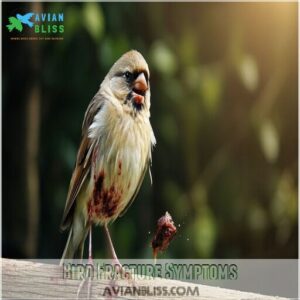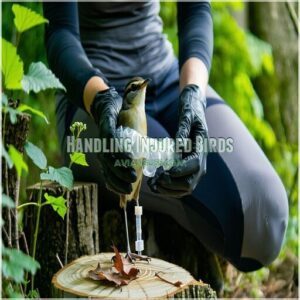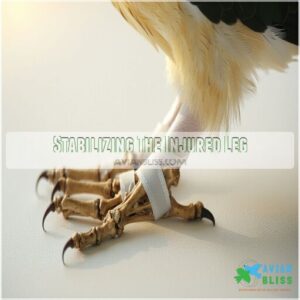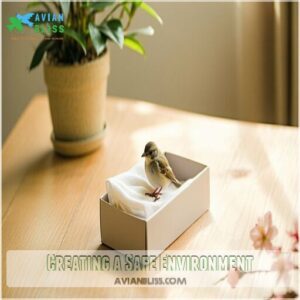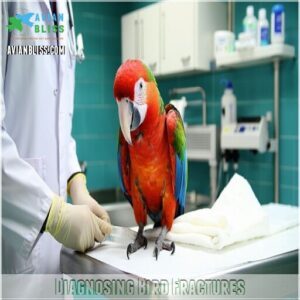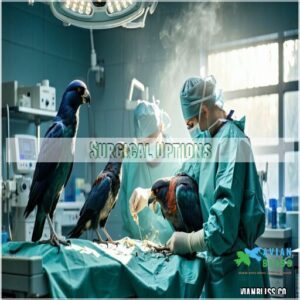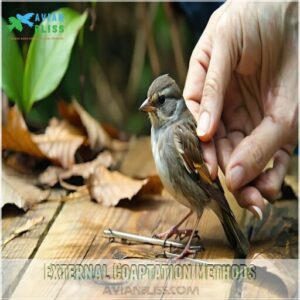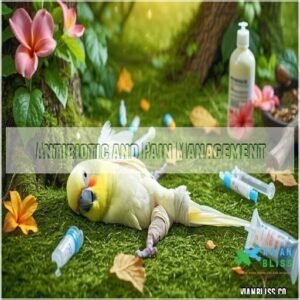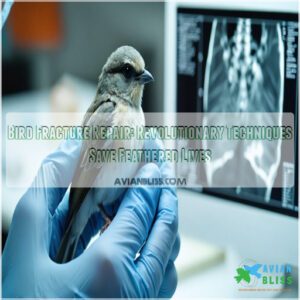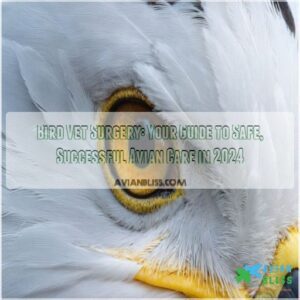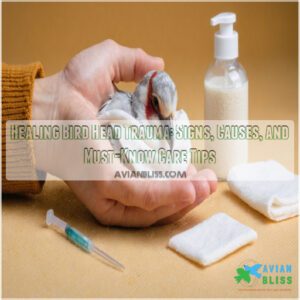This site is supported by our readers. We may earn a commission, at no cost to you, if you purchase through links.
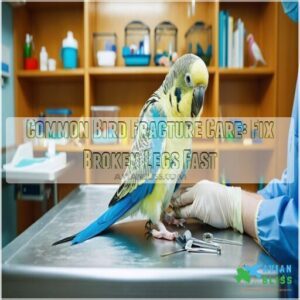
Regarding common bird fracture care, it’s key to identify symptoms like limping, swelling, and deformity.
You’ll want to get your bird to a vet ASAP for an X-ray and proper diagnosis.
Treatment may involve surgery, external coaptation, or antibiotics, and post-operative care is important.
By understanding the ins and outs of common bird fracture care, you’ll be better equipped to nurse your feathered friend back to health – and that’s just the beginning of their road to recovery.
Table Of Contents
- Key Takeaways
- Bird Fracture Symptoms
- First Aid for Birds
- Diagnosing Bird Fractures
- Treating Bird Fractures
- Post Operative Bird Care
- Frequently Asked Questions (FAQs)
- How long do bird fractures take to heal?
- Will a bird broken foot heal on its own?
- Can a bird’s wound heal on its own?
- How do you fix a bird’s wing fracture?
- What causes bird bones to be brittle?
- Can birds fly after leg fracture recovery?
- How long does bird physical therapy last?
- Are bird fractures common in urban areas?
- Do birds experience pain during fractures?
- Conclusion
Key Takeaways
- You’ll need to identify symptoms like limping, swelling, and deformity to provide proper care for your bird’s fracture, and get it to a vet ASAP for an X-ray and diagnosis.
- You’ll have to stabilize the injured leg using splinting techniques and immobilization methods to achieve fracture stability and pain mitigation, and create a safe environment to reduce stress and promote healing.
- You’ll consider surgical options, external coaptation methods, and antibiotic and pain management to treat the fracture, and provide post-operative care to guarantee a smooth healing process.
- You’ll play an important role in your bird’s recovery, and it’s crucial to provide the right care, including physical therapy and rehabilitation, to help your bird regain strength and get back to flying, and prevent future injuries by ensuring proper nutrition, safe enclosures, and handling.
Bird Fracture Symptoms
You’ll need to recognize the symptoms of a bird fracture to provide proper care.
By knowing what to look for, such as limping, swelling, or behavioral changes, you can quickly identify if your bird has a broken leg and take action to help it heal.
Identifying Broken Legs
You’ll often notice a bird with a broken leg limping or avoiding weight on it.
- 5 key signs:
- Limping
- Swelling
- Deformity
- Bleeding
- Hiding behavior, indicating a potential leg injury or fracture.
Visible Signs of Injury
You’ll notice swollen legs, broken feathers, or limping birds.
A leg deformity, blood wounds, or a bird using its wing as a crutch can indicate a fracture.
These visible signs of injury are key bird fracture symptoms, including bird limping or an inability to stand, signaling a potential break.
Identifying leg injury symptoms is essential for proper diagnosis and treatment of bird fractures.
Behavioral Changes
As you observe your bird, look for behavioral changes like pain signals, stress factors, or vocal changes, which can indicate a fracture.
Feeding issues, social withdrawal, and altered bird behavior may also occur, affecting avian health and welfare, requiring attention in bird rehabilitation and wildlife rehabilitation efforts immediately.
First Aid for Birds
You’ll need to act quickly and carefully when providing first aid to a bird with a broken leg, as improper handling can cause further injury.
By following the right steps, you can help stabilize the bird’s injured leg and create a safe environment to reduce stress and promote healing.
Handling Injured Birds
When handling injured birds, you’ll need to prioritize gentle bird handling and injury assessment.
Use avian restraint techniques and provide emergency transport to a safe location, focusing on bird calming to reduce stress.
Ensuring proper injured bird care and bird first aid during emergency bird care and handling is crucial.
It’s key to follow proper bird care guidelines to increase the chances of successful recovery.
Stabilizing The Injured Leg
You’ll need to stabilize the injured leg using splinting techniques and immobilization methods to achieve fracture stability and pain mitigation.
While also considering soft tissue care, using a bird leg splint to immobilize the bird leg fracture for proper fracture stabilization and leg fracture care.
Creating a Safe Environment
To create a safe environment, place the bird in a ventilated box lined with soft cloth, minimizing stress with calming techniques and environmental enrichment, ensuring bird safety and welfare by reducing stress and preventing further injury, promoting bird leg care and overall well-being.
When dealing with injured birds, it’s essential to apply proper emergency first aid techniques to increase their chances of recovery.
Diagnosing Bird Fractures
You’ll need to assess your bird’s injury carefully to determine the best course of action, and that starts with diagnosing the fracture.
By using X-rays and blood tests, you can identify the type and severity of the fracture, which will help you provide the right treatment and care for your bird.
X-rays and Blood Tests
You’ll use X-rays and blood tests to diagnose bird fractures, examining radiograph results and blood work for fracture analysis and medical testing, aiding in Xray diagnosis and radiographic followup to understand fracture characteristics through diagnostic tests and blood tests.
To achieve accurate diagnosis, it’s vital to understand blood testing procedures for effective treatment planning, which involves analyzing the results of these tests to determine the best course of action for the bird’s specific condition.
Common Fracture Types
You’ll encounter various common bird fractures, including:
- Compound fracture
- Comminuted fracture
- Greenstick fracture
- Leg fractures, which require prompt care to prevent further injury, promoting healing and recovery from these common bird fracture types, specifically leg fractures.
Species-Specific Considerations
When diagnosing bird fractures, consider species-specific nuances in avian anatomy and bone density.
As fracture patterns vary across species, requiring customized surgical techniques in avian orthopedics to address unique bird anatomy and species variations, it is crucial to understand these differences.
The customized surgical techniques are essential to effectively treat fractures in birds, taking into account the species variations in bone density and anatomy.
Treating Bird Fractures
You’ll need to assess the bird’s injury carefully to determine the best course of treatment for its fracture.
By considering surgical options, external coaptation methods, and antibiotic and pain management, you can help your bird recover from a broken leg and get back to flying in no time.
Surgical Options
You’ll consider surgical options for complicated fractures, including bone grafting and titanium fixation, to stabilize the bone and promote healing in avian orthopedic surgery.
This is a key aspect of bird fracture repair, utilizing external fixators and avian implants for effective fracture repair and surgical stabilization, particularly focusing on avian orthopedic surgery.
External Coaptation Methods
You’ll explore external coaptation methods, a non-surgical approach to bird fracture care, utilizing splinting techniques and emergency transport to a safe location to stabilize fractures, a key aspect of avian orthopedics and bird splint care.
The use of proper bird splint techniques is essential for successful bird fracture treatment, providing effective fracture stabilization through cast materials and avian orthotics.
Antibiotic and Pain Management
You’ll manage your bird’s pain with medication like meloxicam, and antibiotics will prevent infection, guaranteeing proper wound healing and fracture treatment, with careful attention to medication dosage and antibiotic protocols in avian veterinary care for effective pain relief and infection control.
Effective avian pain relief requires understanding Avian pain management techniques to assure the best possible care for your bird, which involves proper wound healing.
Post Operative Bird Care
You’ll play an important role in your bird’s recovery after surgery, and it’s important to provide the right care to guarantee a smooth healing process.
By following the right post-operative care procedures, you can help your bird recover quickly and effectively from a broken leg, getting them back to flying and living a healthy life.
Physical Therapy and Rehabilitation
You’ll create a rehabilitation plan with exercise techniques like mobility training and physiotherapy to aid physical recovery.
Helping your bird regain strength through regular therapy sessions and flight rehabilitation, a key part of the bird leg rehabilitation process, is crucial for its recovery.
Follow-up Care and Complications
You’ll frequently check on your bird’s fracture healing, watching for infection risk and malalignment issues.
- Monitor pain
- Adjust rehabilitation techniques
- Manage postoperative care to make sure proper bird leg care and prevent long-term effects, which involves careful rehabilitation techniques.
Preventing Future Injuries
You’ll want to prevent future injuries by ensuring proper nutrition, safe enclosures, and handling, while minimizing environmental hazards, to promote bird welfare and prevent leg injuries.
Proper bird disease prevention is also important for the overall health of the birds.
| Prevention | Methods | Benefits |
|---|---|---|
| Nutrition | Balanced diet | Strong bones |
| Enclosures | Safe perches | Reduced falls |
| Handling | Gentle care | Less stress |
| Environmental | Hazard removal | Fewer accidents |
| Injury Proofing | Secure enclosures | Protected birds |
To achieve bird welfare, it is crucial to follow the methods outlined in the table, which includes providing a balanced diet, using safe perches, and ensuring gentle care during handling.
Frequently Asked Questions (FAQs)
How long do bird fractures take to heal?
You’ll find that bird fractures typically heal within 2-3 weeks, with wing fractures taking 45-60 days to regain full flight ability, depending on the fracture’s severity and treatment.
Will a bird broken foot heal on its own?
You’ll need to provide proper care, as a bird’s broken foot won’t heal on its own without treatment, such as splinting or veterinary intervention to guarantee proper healing.
Can a bird’s wound heal on its own?
You’ll be relieved to know that minor bird wounds can heal on their own with proper care, but severe ones often require veterinary attention to prevent infection.
How do you fix a bird’s wing fracture?
You’ll typically fix a bird’s wing fracture with a splint, resetting, or surgery, and provide medication for pain relief and anti-inflammatories to guarantee proper healing and recovery.
What causes bird bones to be brittle?
You’ll discover that bird bones are brittle due to their thin, hollow structure, making them prone to breakage from trauma, poor nutrition, or diseases that weaken their skeletal system naturally.
Can birds fly after leg fracture recovery?
You’ll be thrilled to know that, yes, birds can fly after leg fracture recovery.
But it depends on the severity of the fracture and the quality of care they receive during rehabilitation.
How long does bird physical therapy last?
You’ll undergo bird physical therapy for several weeks, usually 2-3, to maintain joint mobility and guarantee proper healing after a leg fracture, with follow-up appointments to monitor progress.
Are bird fractures common in urban areas?
You’ll find that bird fractures are indeed common in urban areas due to collisions with windows, vehicles, and other obstacles, posing a significant threat to bird safety and well-being always.
Do birds experience pain during fractures?
You’ll notice birds with fractures often exhibit pain through changes in behavior, such as limping, swelling, or avoiding weight on the affected leg, indicating they do experience pain during fractures.
Conclusion
Fearless bird owners, you’re finally fixing fractured feathers with finesse.
By following these steps, you’ll master common bird fracture care, swiftly soothing your bird’s suffering.
Remember, prompt action is key to successful recovery, so prioritize professional help and proper post-operative care for effective common bird fracture care.

